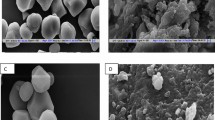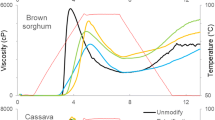Abstract
Purpose
Research exploring pharmaceutical applications of native sorghum and maize crops is needed to improve their economic competitiveness.
Objectives
This work assesses the physicochemical and compressional attributes of pregelatinized sorghum and maize starches originating from Sudan and determines whether these attributes are superior than existing starches in pursuit of achieving quality attributes of pharmaceutical dosage formulations.
Methods
The effects of pregelatinization temperature, starch concentration, and wet massing time were studied in 23 full factorial design. The relevant physical and functional properties such as particle morphology, compressibility index, porosity, particle size distribution, lubricant sensitivity, Heckel and Kawakita plots, and dissolution were systematically examined.
Results
The Hausner ratios (HRs) of unmodified sorghum (1.48) and maize starch (1.39) decreased to 1.22 on pregelatinization. The Heckel parameter of pregelatinized sorghum and maize starches were 29.4 and 17.5, respectively, indicating a high degree of plastic deformation. Low elastic recovery value of 0.29 % indicated low capping and lamination tendency. The coordination number of 8.7 which corresponded to bed voidage of approximately 45 % and Kawakita analysis supported densification by particle rearrangement at low compaction pressures. Swelling power increased fourfold compared to unmodified starches resulting in the faster disintegration of tablets. More than 80 % of drug was released after 10 min from all the formulations. Although lubrication sensitivity values increased marginally, no effect on disintegration time was seen.
Conclusion
The pregelatinized starches mainly sorghum possess superior physical and functional properties and can accommodate minor changes in the formulation composition or process.







Similar content being viewed by others
References
Khar RK, Vyas PS, Farhan JA, et al. Lachman/Lieberman’s. The Theory and Practice of Industrial Pharmacy, 4 ed. New Delhi: CBS Publishers and Distributors Pvt Ltd.; 2013.
Rowe RC, Sheskey PJ, Quinn ME. Handbook of pharmaceutical excipients. 6th ed. London: Pharmaceutical Press; 2009.
Okpanachi GO, Musa H, Isah AB. Physicochemical characterisation of microcrystalline starch derived from Digitaria iburua (Poaceae). Nig J Pharm Sci. 2012;11:66–76.
Subhadhirasakul S, Ketjinda W, Phadoongsombut N. Study on tablet binding and disintegrating properties of alternative starches prepared from taro and sweet potato tubers. Drug Dev Ind Pharm. 2001;27:81–7.
Garr JSM, Bangudu AB. Evaluation of sorghum starch as a tablet excipient. Drug Dev Ind Phar. 1991;17(1):1–6.
Odeku OA. Potentials of tropical starches as pharmaceutical excipients: a review. Starch – Stärke. 2013;65(1-2):89–106.
Adebayo SA, Brown-Myrie E, Itiola OA. Comparative disintegrant activities of breadfruit starch and official corn starch. Powder Tech. 2008;181:98–103.
Adedokun MO, Itiola OA. Disintegrant activities of natural and pregelatinized trifoliate yams, rice and corn starches in paracetamol tablets. J Appl Pharm Sci. 2011;1(10):200–6.
Jubril I, Muazu J, Mohammed GT. Effects of phosphate modified and pregelatinized sweet potato starches on disintegrant property of paracetamol tablet formulations. J Appl Pharm Sci. 2012;2(2):32–6.
Satin M. Functional properties of starches. In: Third Intern. Symp. on Tropical Tuber Crops, held in Thiruvananthapuram, Kerala, India; Jan 19–22, 2000.
Udachan IS, Sahu A, Hend F. Extraction and characterization of sorghum (Sorghum bicolor L. Moench) starch. Int Food Res J. 2012;19(1):315–9.
Yagoub AE, Suleiman AME, Abdel-Gadir W. Effect of fermentation on the nutritional and microbiological of quality of dough of different sorghum varieties. J Sci Tech. 2009;10(3):109–19.
Hamad SH, Dieng MC, Ehrmann MA, et al. Characterization of the bacterial flora of Sudanese sorghum flour and sorghum sourdough. J Appl Microbiol. 1997;83(6):764–70.
Mustafa A, Macmasters M. New varieties of sorghum grain suitable for starch production. Starch-Starke. 1970;22(6):192–5.
Abdallah DB, Charoo NA, Elgorashi AS. Comparative binding and disintegrating property of Echinochloa colona starch (difra starch) against maize, sorghum, and cassava starch. Pharm Biol. 2014;935–943.
Visavarungroj N, Remon JP. An evaluation of hydroxypropyl starch as disintegrant and binder in tablet formulation. Drug Dev Ind Pharm. 1991;17(10):1389–96.
Alebiowu G, Itiola OA. Compressional characteristics of native and pregelatinized forms of sorghum, plantain, and corn starches and the mechanical properties of their tablets. Drug Dev Ind Pharm. 2002;28:663–72.
Núñez Santiagoa MC, Bello-Pe’reza LA, Tecante A. Swelling-solubility characteristics, granule size distribution and rheological behavior of banana (Musa paradisiaca) starch. Carbohydr Polym. 2004;56:65–75.
Abdalla AA, Umsalama MA, Abdelhalim AR, et al. Physicochemical characterization of traditionally extracted pearl millet starch (Jir). J Appl Sci Res. 2009;5(11):2016–27.
Ohwoavworhua F, Adelakun T, Kunle O. A comparative evaluation of the flow and compaction characteristics of a-cellulose obtained from waste paper. Trop J Pharm Res. 2007;6(1):645–51.
Achor M, Oyi AR, Isah AB. Some physical characteristics of microcrystalline starch obtained from maize and cassava. Continental J Pharm Sci. 2010;4:11–7.
Liu Z. Measuring the angle of repose of granular systems using hollow cylinders. Pittsburgh: University of Pittsburgh; 2011.
Wade A, Weller PJ. Handbook of pharmaceutical excipients. London: Pharmaceutical Press; 1994.
Zhang Y, Huang Z, Yang C, Huang A, et al. Material properties of partially pregelatinized cassava starch prepared by mechanical activation. Starch-Starke. 2013;65(5‐6):461–8.
Allen LV, Popovich NG. Ansel’s pharmaceutical dosage forms and drug delivery systems, vol. 306. Baltimore: Lippincott Williams & Wilkins; 2005.
USP36-NF31. United States Pharmacopeial Convention. Rocville 2013
Alebiowu G, Adeagbo A. Disintegrant properties of a paracetamol tablet formulation lubricated with co-processed lubricants. Farmacia. 2009;57(4):500–10.
Adedokun MO, Itiola OA. Influence of some starch mucilages on compression behaviour and quality parameters of paracetamol tablets. Br J Pharm Res. 2013;3(2):176–94.
Rojas J, Aristizabal J, Henao M. Screening of several excipients for direct compression of tablets: a new perspective based on functional properties. Revista de Ciências Farmacêuticas Básica e Aplicada. 2013;34(1):17–23.
Zhang Y, Huo M, Zhou J, et al. DDSolver: an add-in program for modeling and comparison of drug dissolution profiles. AAPS J. 2013;12(3):263–71.
Rippie E, Faiman F, Pramoda M. Segregation of particulate solid systems IV. Effect of particulate shape on energy requirements. J Pharm Sci. 1967;56:1523–5.
Kawakita K, Lüdde KH. Some considerations on powder compression equations. Powder Tech. 1971;4(2):61–8.
Rojas JY, Uribe Y, Zuluaga A. Powder and compaction characteristics of pregelatinized starches. Die Pharmazie. 2012;67(6):513–7.
Garekani HA, Ford JL, Rubinstein MH, et al. Effect of compression force, compression speed, and particle size on the compression properties of paracetamol. Drug Dev Ind Pharm. 2001;27:935–42.
Mohan S. Compression physics of pharmaceutical powders: a review. Int J Pharm Sci Res. 2012;3:1580–92.
Cumberland DJ, Crawford RJ. The packing of particles, vol. 6. Amsterdam: Elsevier; 1987. p. 33.
German RM. Coordination number changes during powder densification. Powder Tech. 2014;253:368–76.
Klevan I. Compression analysis of pharmaceutical powders: assessment of mechanical properties and tablet manufacturability prediction. 2011.
Colonna P, Doublier JL, Melcion JP, De Monredon F, Mercier C. Extrusion cooking and drum drying of wheat starch. I. Physical and macromolecular modifications. Cereal Chem. 1984;61:538–42.
Bos E, Bolhuis GK, Van Doorne H, et al. Native starch in tablet formulations: properties on compaction. Pharm Weekbl Sci. 1987;9:274–82.
Wong L, Pilpel N. Effect of particle shape on the mixing of powders. J Pharm Pharmacol. 1990;42(1):1–6.
Defloor I, Dehing I, Delcour JA. Physico-chemical properties of cassava starch. Starch-Starke. 1998;50:58–64.
US Department of Health and Human Services, Food and Drug Administration (FDA), Center for Evaluation and Research (CDER). Guidances for industry: Waiver of in vivo bioavailability and bioequivalence studies for immediate-release solid oral dosage forms based on a Biopharmaceutics Classification System. 2000
Raihan Sarkar MD, Monjur-Al-Hossain ASM, Saiful Islam MD, et al. Effect of hydrophilic swellable polymers on dissolution rate of atorvastatin using simple physical mixing technique. Ind J Novel Drug Del. 2012;4:130–8.
Author information
Authors and Affiliations
Corresponding author
Ethics declarations
Conflict of interest
The authors report no conflict of interest.
Rights and permissions
About this article
Cite this article
Abdallah, D.B., Charoo, N.A. & Elgorashi, A.S. Assessment of Pregelatinized Sorghum and Maize Starches as Superior Multi-functional Excipients. J Pharm Innov 11, 143–155 (2016). https://doi.org/10.1007/s12247-016-9247-8
Published:
Issue Date:
DOI: https://doi.org/10.1007/s12247-016-9247-8




